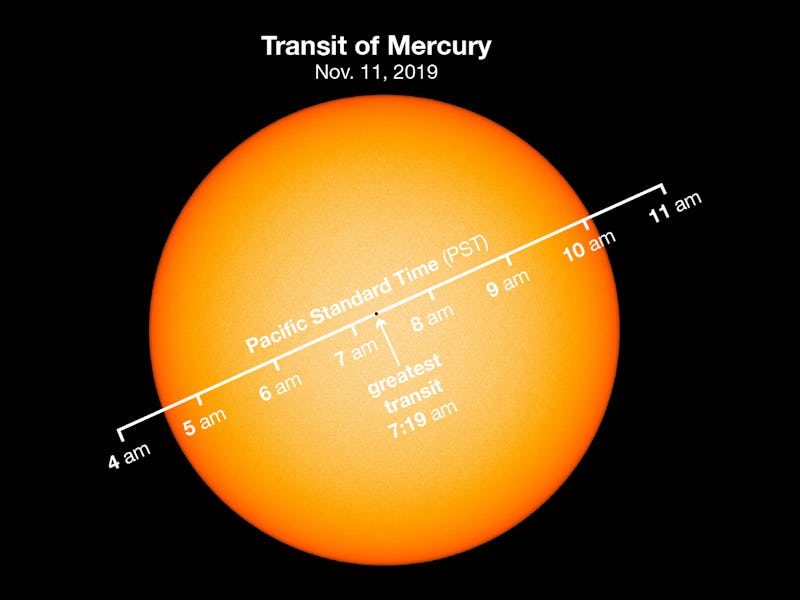Monday's rare transit of Mercury will be the last for at least 13 years
Here’s how you can catch a fleeting glimpse of our Solar System’s smallest planet on its orbital journey.

This Monday, people around the world will be looking to the skies. Mercury, the Solar System’s smallest planet, is set to pass directly between the Earth and our shared star. It’s a rare astronomical phenomenon — and you might be able to watch it.
A Mercury year lasts a mere 88 days — a quick jaunt compared to Earth’s own orbital period of 365 days, or the molasses-like 165-year-long orbit of Neptune, the furthest-most planet from the Sun. As it follows the path of its orbit, Mercury passes between the Sun and Earth every 116 days, but an event like Monday’s only occurs every so often (the last one happened in May 2016).
The reason for the excitement is because this is a transit of Mercury. A transit occurs when the Earth, Mercury, and the Sun are all perfectly lined up with one another — and that only happens a handful of times every century. If all three aren’t in line, Mercury actually looks like it is traveling either above or below the Sun to our Earth-bound eyes.
You might want to set a reminder — the next transit isn’t due for another 13 years, in 2032. And for people in the US, that one won’t actually be visible, according to Sky & Telescope. This is your last chance until 2049.
This map shows where and when across the globe the transit of Mercury will be visible on November 11, 2019.
Here is when and where you can watch this curious phenomenon:
How the see the transit of Mercury in the United States:
On the East Coast, the transit will start a little after dawn, at about 7:30 a.m. Eastern, reaching its zenith by 10:20 a.m. and ending at 1:04 p.m. Unfortunately, that means people in the Midwest and on the West Coast might miss much of the action.
If you don’t have your own equipment or a local astronomy club you can turn to (please do not look directly at the Sun), do not fear: NASA will be posting images taken of the transit throughout the event, starting at 7 a.m. Eastern — you can follow along here.
How to see the transit of Mercury in Europe:
For those in the United Kingdom, the transit kicks off at 12:30 p.m. Greenwich Mean Time. It will reach the Sun’s midpoint at about 3:15 p.m., ending at 6:04 p.m., according to the Royal Astronomical Society. So if you live in the north of the UK or on the European continent, you will be unable to see Mercury cross the Sun’s edge this time.
If you live in London and have the right gear, here is how to view it in-person with the Baker Street Irregular Astronomers. Or get a close encounter with the planet with the Royal Observatory at Greenwich, which will be live-streaming the entire thing. You can also watch it here.
An image of the 2016 transit of Mercury -- the planet is the little black dot in the Sun's lower third.
How to see the transit of Mercury in Africa:
In South Africa, the transit will be visible between 2:30 p.m. and 5 p.m. South African Standard Time, and the South African Astronomical Observatory in Cape Town is opening its doors to the public to see it.
If you are not in Cape Town, the Observatory has put together a map showing the different places across the continent that are holding viewing events the public can join. You can see it here.
How to see the transit of Mercury in the Americas:
Many people in Canada, Central America, the Caribbean and South America will also be able to catch a glimpse of our Solar System’s smallest planet.
The Royal Astronomical Society of Canada has a list of viewing parties happening across the country. See if there is one in your area here.
In Central and South America and the Caribbean, the transit will be visible through the day, according to the UK’s Royal Astronomical Society. From Buenos Aires in Argentina to Havana, Cuba, amateur astronomers and scientists will all get a good view.
More ways to see Mercury:
Bringing astronomy to the people, you can watch the transit via live-stream via the Virtual Telescope.
The site Time and Date is also live-streaming the whole thing here.
And then of course there is always NASA to the rescue.